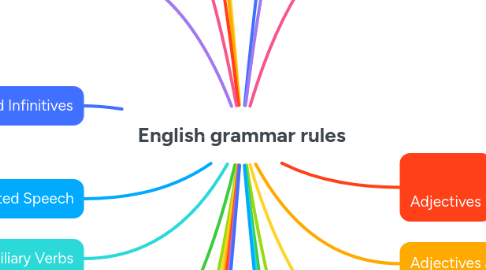
1. Articles
1.1. Definite Article
1.1.1. "The" is used to refer to specific nouns. For example, "the book on the table."
1.2. Indefinite Articles
1.2.1. "A" and "An" are used to refer to nonspecific nouns. "A" is used before consonant sounds, and "An" before vowel sounds. For example, "a cat" vs. "an apple."
2. Prepositions
2.1. - Prepositions show relationships between a noun (or pronoun) and other words in a sentence. For example, "The book is on the table."
3. Punctuation
3.1. Periods
3.1.1. End declarative sentences. For example, "She walked home."
3.2. Commas
3.2.1. Separate items in a list, clauses, or phrases. For example, "I bought apples, oranges, and bananas."
3.3. Quotation Marks
3.3.1. Enclose direct speech or quotations. For example, "She said, 'Hello.'"
3.4. Apostrophes
3.4.1. Show possession or form contractions. For example, "Mary's book" or "don't."
4. Conjunctions and Sentence Connectors
4.1. Coordinating Conjunctions
4.1.1. For, and, nor, but, or, yet, so (FANBOYS).
4.2. Subordinating Conjunctions
4.2.1. Connect dependent clauses to independent clauses. For example, "because," "although," "if."
4.3. Conjunctive Adverbs
4.3.1. however, therefore, moreover, consequently, etc.
5. Common Mistakes
5.1. Run-on Sentences
5.1.1. Avoid combining multiple independent clauses without proper punctuation or conjunctions.
5.2. Sentence Fragments
5.2.1. Ensure each sentence has a subject and a verb and expresses a complete thought.
5.3. Misplaced Modifiers
5.3.1. Place modifiers next to the word they modify. For example, "She almost drove her kids to school every day" vs. "She drove her kids to school almost every day."
6. Gerunds and Infinitives
6.1. Gerunds
6.1.1. Verb forms ending in -ing used as nouns. "Swimming is fun."
6.2. Infinitives
6.2.1. "To" + base form of the verb. "To swim is fun." - Some verbs are followed by gerunds (e.g., enjoy, avoid), while others are followed by infinitives (e.g., decide, plan).
7. Reported Speech
7.1. Changing direct speech to indirect speech. For example, "She said, 'I am tired'" becomes "She said that she was tired."
8. Auxiliary Verbs
8.1. Used with main verbs to form questions, negatives, and different tenses. Common auxiliary verbs are "be," "do," and "have." For example, "Do you know?" "She is running," "They have finished."
9. Sentence Types
9.1. Simple Sentence
9.1.1. One independent clause. For example, "She runs."
9.2. Compound Sentence
9.2.1. Two or more independent clauses joined by a conjunction or semicolon. For example, "She runs, and he swims."
9.3. Complex Sentence
9.3.1. One independent clause and at least one dependent clause. For example, "She runs because she enjoys it."
9.4. Compound-Complex Sentence
9.4.1. Two or more independent clauses and at least one dependent clause. For example, "She runs because she enjoys it, and he swims."
10. Prepositional Phrases
11. Verb Patterns with Gerunds and Infinitives
12. Appositives
13. Ellipsis
14. Parallel Structure
15. Subjunctive Mood
16. Quantifiers
17. Sentence Structure
17.1. Subject-Verb-Object (SVO)
17.1.1. This is the basic sentence structure in English. For example, "She (subject) loves (verb) books (object)."
17.2. Subject-Verb Agreement
17.2.1. The subject and verb must agree in number. For example, "He runs" (singular) vs. "They run" (plural).
17.2.2. The subject and verb must agree in number. For example, "He runs" (singular) vs. "They run" (plural).
17.2.3. The subject and verb must agree in number. For example, "He runs" (singular) vs. "They run" (plural).
18. Capitalization
18.1. Always capitalize the first word of a sentence, proper nouns, and titles. For example, "She went to Paris."
19. Verb Tenses
19.1. Simple Tenses
19.1.1. - Present (I eat)
19.1.2. - Past (I ate)
19.1.3. - Future (I will eat)
19.2. Continuous/Progressive Tenses
19.2.1. - Present Continuous (I am eating)
19.2.2. - Past Continuous (I was eating)
19.2.3. - Future Continuous (I will be eating)
19.3. Perfect Tenses
19.3.1. - Present Perfect (I have eaten)
19.3.2. - Future Perfect (I will have eaten)
19.3.3. - Past Perfect (I had eaten)
20. Adjectives
20.1. Modify nouns and pronouns. For example, "a beautiful day."
21. Adjectives and Adverbs
21.1. Adverbs
21.1.1. Modify verbs, adjectives, and other adverbs. For example, "He runs quickly."
22. Nouns and Pronouns
22.1. Singular and Plural Nouns
22.1.1. Most nouns add -s or -es for plurals (e.g., cat/cats, box/boxes). Some have irregular forms (e.g., child/children, mouse/mice).
22.2. Pronoun Agreement
22.2.1. Pronouns must agree with their antecedents in number and gender. For example, "Everyone must bring their own lunch."
23. Conditional Sentences
23.1. Zero Conditional
23.1.1. General truths. "If you heat water, it boils."
23.2. First Conditional
23.2.1. Real future possibilities. "If it rains, we will stay home."
23.3. Second Conditional
23.3.1. Unreal or unlikely present/future situations. "If I were you, I would apologize."
23.4. Third Conditional
23.4.1. Past situations that did not happen. "If I had known, I would have called."
24. Modal Verbs
24.1. - Express necessity, possibility, permission, and ability. Common modals include "can," "could," "may," "might," "must," "shall," "should," "will," and "would." For example, "You must study," "Can I help you?"
25. Comparatives and Superlatives
25.1. Comparatives
25.1.1. "er" or "more" (e.g., taller, more beautiful).
25.2. Superlatives
25.2.1. "est" or "most" (e.g., tallest, most beautiful).
